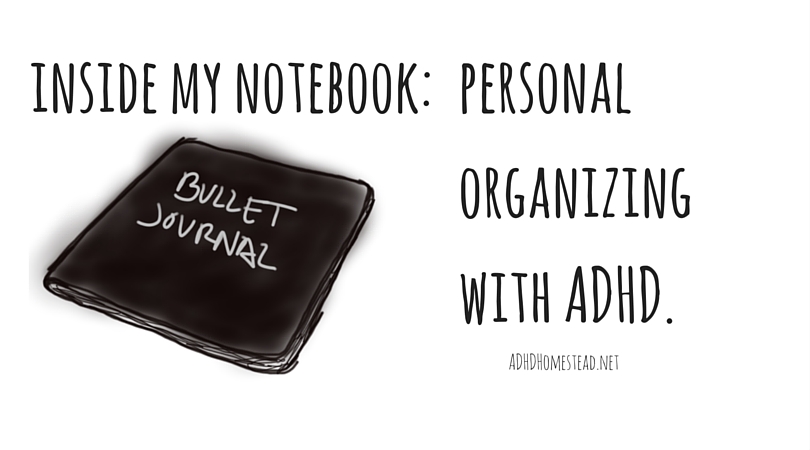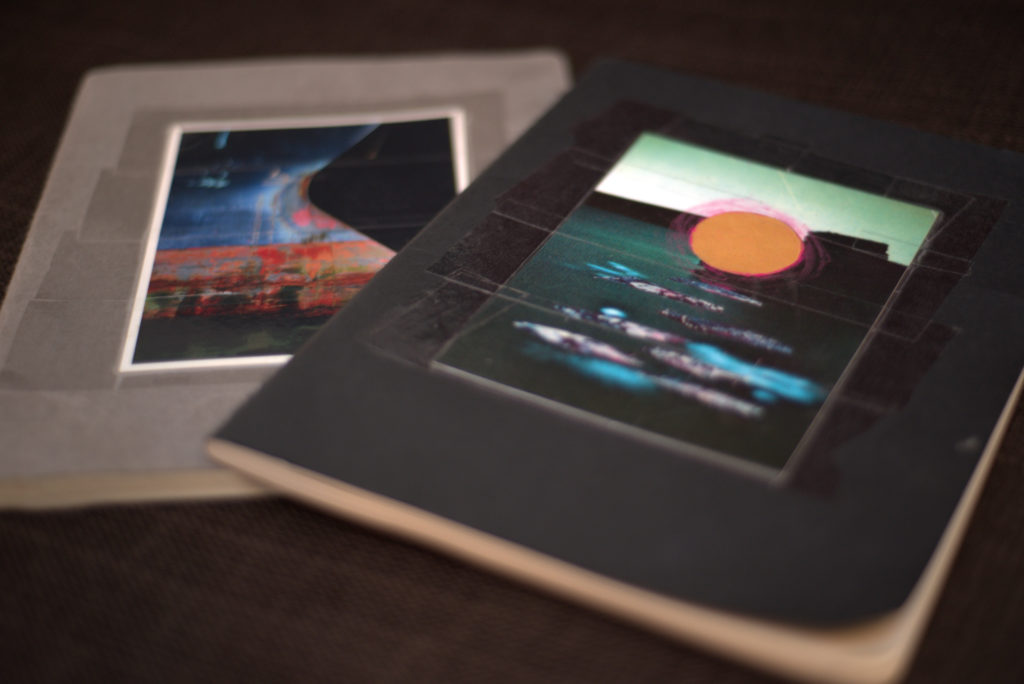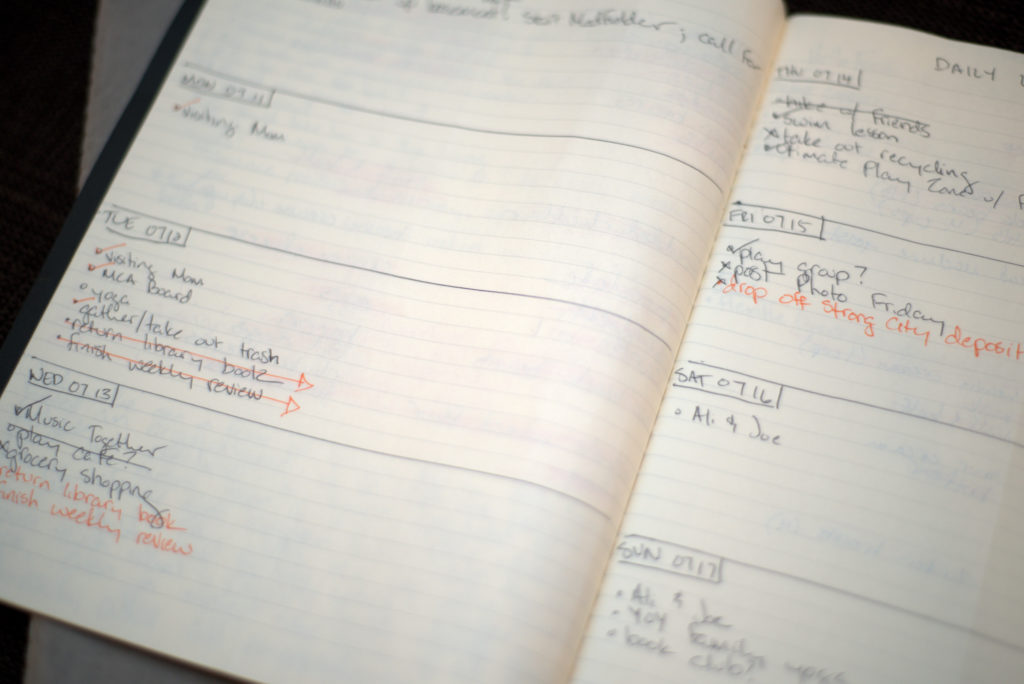Organizing my daily life: it feels like both the starting point and the impossible dream with adult ADHD. It’s also a basic expectation of adulthood.
Most ADHD’ers know we need an organizational system, but feel like nothing works. We struggle to find answers to the all-important question, “but how?”
A naturally organized person with a manageable schedule might answer, “you just do it.” Adults with ADHD rarely “just do” anything.
Today, I’ll share a simple, low-tech, flexible way to stay organized. It’s called Bullet Journal. First I’ll provide a look inside my notebook, then I’d love to answer questions in the comments. Personal organizing has been a pet project of mine for many years. If you want to talk about the nitty gritty, I’m your girl.

What is Bullet Journal?
Bullet Journal isn’t an app or a product. It’s an idea, best explained in this short, engaging little video:
I use apps to stay organized, but I appreciate a tactile element. Screens can feel too abstract. I’ve carried a notebook everywhere since the seventh grade. I’ve dallied with day planners, but fallen away from them since the advent of smart phones. Nowadays, I use my notebook for everything: Grocery lists. jotting down ideas, drafts, or outlines for writing projects. Taking notes at meetings. On-the-fly to-do lists. Goal-setting exercises. Everything imaginable.
Bullet Journal helps me organize those elements and keep me from losing track of what I write down. Because I have ADHD and a very poor memory, I write nearly everything down.
Adults with ADHD are individuals — Bullet Journal is flexible.
I love Bullet Journaling’s infinite flexibility. I chose the size, feel, and contents of my notebook to make it something that works for me. This is especially important for adults with ADHD. If a system or tool isn’t easy, comfortable, and even fun to use, it won’t last long.
I keep my Bullet Journal in Moleskine’s extra-large ruled notebook. In the spirit of Marie Kondo’s KonMari method, I use postcards — mostly collected from art shows — to make the notebooks special and joyful to use.

I always add an entry to the index or add a page number to an existing entry before adding the content. Otherwise, I can get distracted and forget to update the index.

Bullet Journal’s flexibility extends inside the notebook, too, allowing me to integrate new concepts while ditching what doesn’t work. For example, I never look at my Future Log. I’d love to examine my six-month view more often, but I’ve come to accept — with compassion and objectivity, of course — that it’s not going to happen with this life and this brain. My next Bullet Journal won’t have a Future Log. Instead, I may beef up the Monthly Log, which I include in my weekly review.
I also added pages to the front of my Bullet Journal to remind me of my many responsibilities and spheres of influence. Stephen Covey calls these “roles and goals” in his book, 7 Habits of Highly Effective People. In Getting Things Done, David Allen refers to them as “areas of focus and accountabilities.” Either way, I maintain a space in my notebook to reflect on my roles in the world and my goals for each. I skim over these pages at my weekly review.

Using my Daily Log with Google Calendar
I use Google Calendar to track all events, meetings, and time-sensitive tasks. I copy entries from my Google Calendar to the Daily Log as part of my weekly review. I never add directly to the Daily Log, always Google Calendar. It’s critical for me to respect my primary resource/repository for a specific kind of information.

You might be wondering why I recopy rather than print my calendar and paste it into the notebook (or look at the widget on my phone’s home screen). The tactile experience of writing helps me encode/process information. I also never take notes on a laptop or tablet, only with pen and paper, because I remember conversations more clearly that way.
Taking time to write down my schedule, deadlines, and obligations for the week helps me think it through. I wouldn’t get this from skimming my Google Calendar.
Notice the lack of to-do items under each day? My to-do list is long, and nowhere near my Daily Log. I use David Allen’s Getting Things Done system, which discourages “daily to-do lists.” I only tie a task to a day if it really must happen then: in other words, it becomes irrelevant or incurs a late fee.
Let’s chat in the comments.
When I say I use my notebook for everything, I mean everything, from grocery lists to a race bib from a recent 5k run. The Daily Log and Monthly Log pages keep everything in a rough chronological order, and the index lets me return and add to previous entries.

Have you tried something like this before? How did it go? Are you hesitant to try it because you think it won’t work? Please share your questions and experiences in the comments. I’d love to chat!
Hey there! Are you enjoying The ADHD Homestead?
Here's the thing: I don't like ads. I don't want to sell your attention to an advertising service run by the world's biggest data mining company. I also value my integrity and my readers' trust above all, which means I accept very few sponsorships/partnerships.
So I'm asking for your support directly. For the cost of one cup of coffee, you can help keep this site unbiased and ad-free.
Below you will find two buttons. The first lets you join our crew of Patreon pals and pledge monthly support for my work. Patrons also have access to my Audioblogs podcast. The second takes you to a simple donation page to pledge one-time or recurring support for The ADHD Homestead, no frills, no strings. Do whichever feels best for you!

